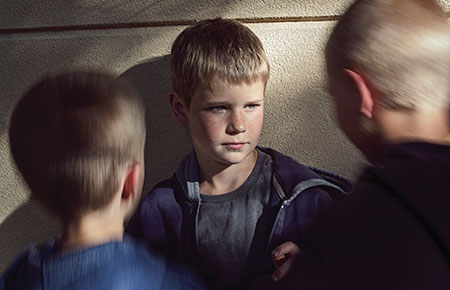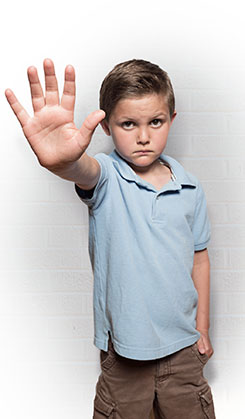520. The Worth of Souls, and the Problem of Bullying. from LDS.org. Great article!
I actually remember at least 2 times I was "bullied" in my elementary years. They both involved things being said to me that were unkind.I won't go into what happened, but it really hurt my feelings, and made me feel like people didn't like me. I probably kept that feeling well into high school.
I remember telling my children the first of each school year to watch and if they saw someone, especially a new student in the school, that seemed lonely or ignored by others, to be sure and befriend them.



I remember telling my children the first of each school year to watch and if they saw someone, especially a new student in the school, that seemed lonely or ignored by others, to be sure and befriend them.
The Worth of Souls and the Problem of Bullying

Photo illustration by David Stoker
In this dispensation, the Lord made it clear in a revelation to the Prophet Joseph Smith that “the worth of souls is great in the sight of God” (D&C 18:10). Ideally, all people would treat each other with respect and kindness and as individuals of great worth. Unfortunately, not everyone lives up to this principle.
The problem isn’t unique to our day. In the Book of Mormon, we read how Laman and Lemuel called their younger brother Nephi names, hit him, tied him up, and tried to kill him. They were bullies.
The definition of bullying we have today could well have applied in Nephi’s time: “Unwanted, aggressive behavior … that involves a real or perceived power imbalance. The behavior is repeated, or has the potential to be repeated, over time.”1
Bullying comes in many forms, including verbal, physical, sexual, relational (damaging someone’s relationships or social status), and cyber (bullying through electronic devices).2 Because bullying is very common, chances are that your children will experience it at different points in their lives, perhaps both as victims and as bullies.3
Thankfully, there are ways to deal with bullying that help children feel safe and empowered and give bullies opportunities to change. As you teach your children the relevant principles and skills, they can help others and more effectively avoid being on either side of a bullying situation.
If Your Child Is Being Bullied
Whether or not you currently have a child involved in a bullying situation, it is important to create a relationship with your children in which they feel comfortable talking with you about their lives. Encourage them to tell you if they see or experience bullying themselves. You can also watch for changes that may signal that something is wrong: if they become more irritable, sad, or anxious, or if they begin to avoid people or places they used to enjoy, they may be experiencing bullying.
If your child is being bullied or sees someone else being bullied, help him or her take effective, assertive action. Although common recommendations include ignoring the bully, turning bullying behavior into a joke, or reacting aggressively, these responses are actually often ineffective and dangerous. Instead, teach your child to:
- • Look the bully in the eye.
- • Tell the bully calmly and firmly that his or her actions are bullying: “This is bullying, and it’s not okay.”
- • Ask the bully to stop doing it: “I need you to stop.”
- • If the bullying continues, repeat the same message and tell the bully that an adult authority figure will be informed: for example, “I will tell the teacher what you are doing.”

Photo illustration by David Stoker
If the bullying still doesn’t stop after the above steps, you or your child should inform an authority figure about the situation and continue speaking up until your child or any others being bullied have gotten the help they need. The authority figure involved first should be the one closest to the situation—a school or church teacher, recess monitor, parent, or member of the presidency of the ward Primary, Young Men, or Young Women. If the bullying continues, you and your child should seek out the authority figure just higher than the last. You may need to continue going up the chain of authority until the bullying stops.
During this time, you and your child should keep all evidence of the bullying in case you need to ask local law enforcement or a lawyer for help. Make a list of events and the dates they occurred, ask your child for any notes, print copies of emails and texts, and take screenshots of social media posts that contain bullying messages.
This approach does not guarantee that the bullying will stop. It may even increase the bullying in the short term. Remember that Laman and Lemuel continued to bully Nephi even after an angel intervened (see 1 Nephi 3:29; 4:4; 7:16). However, an assertive and direct approach is the best way to help your child stop the bullying. Additionally, this approach shows love toward the bully by allowing him or her an opportunity to repent and change the behavior.
Helping Your Child Love Others
No parent wants to imagine his or her child as a bully, but there’s a chance children will bully their siblings or others at some point in their lives. For example, my parents were not aware that as a teenager I would push my younger sister down onto the couch, sit on her, and laugh at her while not allowing her to get up. If my parents had known, they would have acted quickly to stop my behavior.
One helpful way to prevent bullying behavior is to teach your children to love other people, even when those people seem different. Elder Dallin H. Oaks of the Quorum of the Twelve Apostles stated, “We should be persons of goodwill toward all, rejecting persecution of any kind, including persecution based on race, ethnicity, religious belief or nonbelief, and differences in sexual orientation.”4
Teach your children to avoid saying mean things or acting in an aggressive or exclusionary way toward their peers. If you see or hear of your children bullying someone, speak to them privately, kindly, and directly. Tell them that what they are doing is bullying and it needs to stop immediately. Often children aren’t fully aware that their actions are harmful. Most children want to make good choices and will readily take correction, especially when it is followed by “an increase of love” (D&C 121:43).
There Is Hope
Another great tool against bullying is an understanding that we are all children of God and have great worth. As we help our children develop a testimony of these important truths, they will learn to love themselves and others, even those who are different from them (seeLuke 10:30–37). One of the most important gifts we can give our children is a safe place to turn if they need help. We can remind them that they are not alone and that there is always hope.
Use this article, along with stories on this topic in the September and October Friend, to talk with your children about bullying. See also the following videos: “Bullying—Stop It” (lds.org/go/bullyingE1015); “Angels in Disguise” (lds.org/go/angelsE1015).
Sticking Up for a Friend

Photo illustration by Robert Casey
We watched a Mormon Messages video in family home evening about cyberbullying. A month or so later, one of my friends (I’ll call her Molly) posted a video on a social networking site being nasty to another one of my friends (I’ll call her Sarah). I was surprised she did it, as they used to be best friends, and Molly would never have said such things to Sarah’s face. Another girl had “liked” it. I wasn’t sure if I should say something, because I don’t like confrontations. My mum asked how I’d feel if the video was about me and none of my friends said anything.
I decided to leave a comment that nicely let Molly know I didn’t like what she had posted. I also reported the video as inappropriate because it was bullying.
The next day I checked the site. The video had been taken down, but Molly had now posted it directly to us. This time nobody “liked” it, and two other people wrote comments similar to mine, sticking up for Sarah. Molly then blocked me and another girl but got rid of the video.
I was upset that Molly reacted like that, but I felt pleased I’d been a good influence. And I was pleased that others had stood by our friend too. I hope Molly has learned that good friends don’t do mean things like that and that we’ll say something if they do. I also hope Molly knows we would stick up for her too.
- 1. “Bullying Definition,” stopbullying.gov/what-is-bullying/definition/index.html.
- 2. See Alessio Vieno, Gianluca Gini, and Massimo Santinello, “Different Forms of Bullying and Their Association to Smoking and Drinking Behavior in Italian Adolescents,” Journal of School Health, vol. 81, no. 7 (July 2011), 393–99.
- 3. See Jing Wang, Ronald J. Iannotti, and Tonja R. Nansel, “School Bullying among Adolescents in the United States: Physical, Verbal, Relational, and Cyber,” Journal of Adolescent Health, vol. 45, no. 4 (Oct. 2009), 368–75; Kirk R. Williams and Nancy G. Guerra, “Prevalence and Predictors of Internet Bullying,”Journal of Adolescent Health, vol. 41, no. 6, suppl. (Dec. 2007), S14–S21.
- 4. Dallin H. Oaks, “Loving Others and Living with Differences,” Ensign, Nov. 2014, 27.



Comments